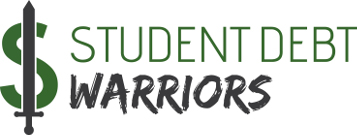If you’re a college grad who’s having trouble paying back your student loans, here’s some good news: You may be able to qualify for student loan discharge or forgiveness if you meet certain eligibility requirements. But what is student loan forgiveness or discharge, and how are they different?
Need help keeping track of your student loans? Download our free Student Loan Spreadsheet!
Discharge vs. Forgiveness: What’s the Difference?
Under normal circumstances, you must pay back your student loans even if you are unhappy with the education you received, don’t finish college, or can’t find a job in your field of study. Even if you are going through a bankruptcy, student loans are notoriously difficult to get rid of (though not impossible). But in some cases, you may qualify for loan discharge or forgiveness.
Okay, so what’s the difference between discharge and forgiveness? Student loan forgiveness and student loan discharge both involve the cancellation of your federal student loans, but the ways that you qualify for each is different. (Note: Sometimes, private student loans can be discharged under specific circumstances, but these vary by lender.)
To qualify for forgiveness, you typically must work for a certain amount of time in a particular field, especially in high-need areas. Forgiveness can be granted regardless of the student’s ability to repay. Discharge, on the other hand, is granted wen serious qualifications are met; these can include improprieties done on the part of your university, or other things that make it unlikely that you will ever be able to repay your debt.
Student Loan Discharge
Aside from bankruptcy, there are six ways that you may qualify for student loan discharge of federal student loans:
- Closed School Discharge: If your school closes while you are enrolled and you can’t complete your program because of the closure you may be able to discharge your student loans. This may also qualify if the school closes within 120 days after you withdraw. You would not qualify for discharge if you complete a similar program at another school by transferring credits or if you have completed all of the coursework for the program (even if you haven’t received your degree!). This would apply to Direct Loans, FFEL Program Loans, and Perkins Loans.
- Total and Permanent Disability Discharge: If you become totally and permanently disabled, you may receive what is called a “TPD Discharge.” To qualify, you must prove that you are unable to find employment due to some kind of disability. You may qualify if you were injured in the line of duty, if you are receiving Social Security Disability Insurance, or if you can prove through a physician that you are totally and permanently disabled in a way that might result in death, has lasted for at least 60 months, and can be expected to continue for at least another 60 months. This would apply to Direct Loans, FFEL Program Loans, and Perkins Loans.
- Death Discharge: If the student borrower dies (which we hope isn’t the case!) then the loans will be discharged. Similarly, if a parent borrower of a Parent PLUS loan (or the student that the loan was taken out for) dies, then the loan may be discharged. This would apply to Direct Loans, FFEL Program Loans, and Perkins Loans.
- False Certification of Student Eligibility or Unauthorized Payment Discharge: This type of discharge is related to misdeeds done by your university. These include things like your school falsely claiming how you may benefit from its training; the school signing your name on the application or promissory note without your authorization; or a few other reasons. This would apply to Direct Loans and FFEL Program loans, but not to Perkins Loans.
- Unpaid Refund Discharge: If you withdrew from your university within a certain time frame and your university did not refund the loan to the U.S. Department of Education (or other lender) then you may be eligible for discharge. This would apply to Direct Loans and FFEL Program loans, but not to Perkins Loans.
- Borrower Defense Discharge: Similar to the False Certification of Student Eligibility Discharge above, Borrower Defense Discharge may be granted when your university misleads you or engages in misconduct in violation of certain state laws. This can apply to Direct Loans and sometimes FFEL Program Loans, but not to Perkins Loans.
Student Loan Forgiveness
By working in certain high-need areas or careers, you may be able to qualify for three different types of forgiveness on your federal student loans. These forgiveness options, especially when paired with an income driven repayment plan, can save you a lot of money:
- Teacher Loan Forgiveness: This type of forgiveness impacts teachers who have been teaching full-time in a low-income elementary or secondary school or other educational service agency for five years, back-to-back. Up to $17,500 of your subsidized and unsubsidized loans may be forgiven in this way, but PLUS Loans cannot be included. Perkins Loans also cannot be forgiven in this way, but may qualify under Perkins Loan Cancellation and Discharge (see below).
- Public Service Loan Forgiveness: Public Service Loan Forgiveness is available for those employed by governmental organizations and not-for-profit organizations. The program forgives whatever balance you still owe on your Direct Loans after you have made 120 “qualifying monthly payments” while working full-time for a qualified employer. FFEL Program Loans and Perkins Loans cannot qualify for this type of forgiveness.
- Perkins Loan Cancellation and Discharge: A portion of your Perkins Loans may qualify for forgiveness if you work in certain high-need fields (yes, it’s called “discharge,” but it’s really “forgiveness”). The total amount possible for forgiveness varies by occupation and length of time. This includes volunteers in the Peace Corps, teachers, members of the armed forces serving in areas of hostility, nurses or medical technicians, law enforcement or correction officers, “Head Start” workers, child or family services workers, and other professional providers of early intervention services. For a complete breakdown of forgiveness amounts on Perkins Loans, you should check out this chart.
Know Before You Apply
The rules for various kinds of student loan discharge and forgiveness can be dramatically different, so before you assume that you qualify (or get your hopes up) it would be wise to contact your university or student loan servicer to ensure that you do. The information compiled here is a great jumping-off point, but you’ll need to do your own research to make sure you qualify.
It’s also important to note that if you have federal student loans that are forgiven or discharged, the government will consider this taxable income for the year in which the discharge or forgiveness took place. So if, for example, you received a discharge of $20,000 in student loans this year, then come tax season you would owe taxes on that $20,000. That can certainly make for a hefty tax bill, especially as the amount forgiven or discharged grows, so if you are building discharge or forgiveness into your student loan repayment plan then it’s important to take it under consideration and plan for it.
A Note About Refinancing
You might have been told that refinancing your student loans could help you save money or lower your interest rates, which, if you’re like any other human being, probably piqued your interest. While it’s true that refinancing can make repaying your loans easier, you should know that if you refinance your federal student loans, they become private student loans—at that means you are giving up certain safety nets, like the forgiveness options outlined above.
Is that a reason not to refinance? I don’t know, it might be. It completely depends on your own personal financial situation, needs, and goals. If you went to college to become a teacher, for example, knowing that you could discharge your student loans after five years of working in a low-income area, then you probably don’t want to refinance in your fourth year, even if doing so would save you some money thanks to a lower interest rate. If, on the other hand, you didn’t plan on using any of these forgiveness options, or if you don’t qualify for any of them anyway, then you might want to consider refinancing.






